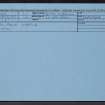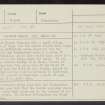Ogilface Castle
Castle (Medieval)(Possible)
Site Name Ogilface Castle
Classification Castle (Medieval)(Possible)
Alternative Name(s) Barbauchlaw Glen
Canmore ID 47772
Site Number NS96NW 1
NGR NS 9270 6901
Datum OSGB36 - NGR
Permalink http://canmore.org.uk/site/47772
- Council West Lothian
- Parish Torphichen
- Former Region Lothian
- Former District West Lothian
- Former County West Lothian
NS96NW 1 9270 6901.
(NS 9270 6901) Ogilface Castle (NR) (Site of)
OS 6" map (1922)
Ogilface Castle (Remains of): a small oblong building, walls 3' high, but the inside filled with ruins. There is nothing definitely known about it, but the tradition is that the Covenanters made it a place of defence and protection; it is also stated that there is a large excavation in the ridge under the ruins. It was the seat of the ancient family of de Bosco, barons of Ogilface, passing into the possession of the Earls of Linlithgow, and upon the fall of that family, ceased to exist as a barony and was sold in portions to different proprietors. It appears to have been a place of some strength, though of no great size.
New Statistical Account (NSA) 1845; Ordnance Survey Name Book (ONB) 1856; F Groome 1902
A small natural ridge juts into Barbauchlaw Glen, and it was upon this that the castle possibly stood. There is a low stony bank which may be the remains of the wall mentioned above. No further information was found about the castle.
Visited by OS (JLD) 18 November 1952
Field Visit (25 February 1924)
Ogilface Castle (Remains of).
Although the O.S. map has the entry as "Ogilface Castle. Remains of," at Woodend, half a mile north-west of Armadale, nothing remains but the site (cf. No. 380 [Bedlormie]).
RCAHMS 1929, visited 25 February 1924
OS 6-inch map: viii N.E.
Project (2007 - 2007)
NS 9270 6901 Ogilface Castle (NS 96 NW1) stood on a small promontory formed between the Barbauchlaw Burn and a burn that enters from the N side.
At its E end the level area of the promontory is less than 20m wide. A ground resistance survey was made over four 20 x 20m squares running W from this end with a further square on the N where the promontory widens. A magnetometry survey was made over the first four of these squares. The castle appears, on the resistivity survey, as a high resistance 7m square with less clear highs to the E and W. The magnetometry survey shows a 9m square to the E of the square resistive high but did not detect that square well. It is probable that the E square is constructed of igneous stone. A possible wall, indicated by a high resistance line, runs for some 40m W along the scarp of the promontory on the S side. High resistance spots on the N scarp could also represent a wall; there is evidence of collapsed stonework into the burn. Less clear linear highs extend 50m W from the castle; some suggest walls and rectangular buildings giving the site an overall length of 80m. Resistance and magnetic printouts correlate well.
Report copies will be deposited with HS, RCAHMS and WoSAS.
Funded by: Historic Scotland, Dr John Wells, History of Armadale Association, Dr Peter Morris, Edinburgh Archaeological Field Society.
Magnetometry (2007 - 2007)
NS 9270 6901
A magnetometry survey was made over the first four of these squares. The castle appears, on the resistivity survey, as a high resistance 7m square with less clear highs to the E and W. The magnetometry survey shows a 9m square to the E of the square resistive high but did not detect that square well.
Report copies will be deposited with HS, RCAHMS and WoSAS.
Funded by: Historic Scotland, Dr John Wells, History of Armadale Association, Dr Peter Morris, Edinburgh Archaeological Field Society.
Earth Resistance Survey (2007 - 2007)
NS 9270 6901 A ground resistance survey was made over four 20 x 20m squares running W from this end with a further square on the N where the promontory widens.
Report copies will be deposited with HS, RCAHMS and WoSAS.
Funded by: Historic Scotland, Dr John Wells, History of Armadale Association, Dr Peter Morris, Edinburgh Archaeological Field Society.
Aerial Photography (2007)
This open-ended project that began in 2007 aims to photograph archaeological and potential archaeological
sites in West Lothian and to produce images that are readily accessible to those interested in the archaeology and history of the area. In some cases this may lead to more detailed archaeological investigations.
We take photographs with a camera suspended from a kite line at not more than 50m above the ground. Images are captured in visible channels and also in the near infra-red. We are also experimenting with digital ultra-violet photography.
NS 9270 6901 At the Ogilface Castle site, images produced in normal, visible lighting conditions agree
well with both plane table and geophysics surveys carried out by EAFS and Dr Peter Morris. Images produced in the infra-red (as well as some conventional images) show other details depending on whether the photograph was taken in bright or low sunlight, or in overcast conditions around midday. The significance of these details is unknown.
Archive: RCAHMS (Representative images)
Funder: Rosie Wells and John Wells
Rosie Wells and John Wells – History of Armadale Association
Earth Resistance Survey (2008)
NS 9270 6901 Ogilface Castle stood on a small promontory between the Barbauchlaw Burn and a burn that joins from the N. It was the subject of area resistive and magnetic surveys (DES 2007, 194) and a limited excavation some 20 years ago which recorded a ‘set of descending steps’. This survey of 42m across the middle of the building outlines was made to see whether any downward-sloping resistive feature could be detected. High resistance, descending at 45° to a depth of about 1m, was found on the W side of a square feature. The dimensions of the square feature and the descending steps are almost identical to those at Cramond Tower, suggesting a tower house built for the de Bosco family.
Report: HS, RCAHMS and WoSAS (intended)
Funder: Historic Scotland, Dr John Wells, History of Armadale Association, Dr Peter Morris and Edinburgh Archaeological Field Society
David Jones (Edinburgh Archaeological Field Society), 2008
Magnetometry (2008)
Area ground resistance and magnetometry surveys were made over two sites to the west of Armadale. The first is recorded by RCAHMS as Ogilface Castle (site of) standing on a narrow ridge that juts eastwards into the Barbauchlaw Glen. The ground resistance survey was made over four 20 by 20m squares proceeding to the west from the eastern end of the promontory with one further square added to the north of the fourth square where the promontory widened. The magnetometry survey was made at a later date over the first four of these squares.
Funder: Historic Scotland, Dr John Wells, History of Armadale Association, Dr Peter Morris and Edinburgh Archaeological Field Society
David Jones (Edinburgh Archaeological Field Society), 2008
Project (2008)
Area ground resistance and magnetometry surveys were made over two sites to the west of Armadale. The first is recorded by RCAHMS as Ogilface Castle (site of) standing on a narrow ridge that juts eastwards into the Barbauchlaw Glen. The ground resistance survey was made over four 20 by 20m squares proceeding to the west from the eastern end of the promontory with one further square added to the north of the fourth square where the promontory widened. The magnetometry survey was made at a later date over the first four of these squares.
The printouts of the resistance and magnetometry surveys correlate well with an apparent double? Tower at the eastern end. Magnetometry shows up one section better than that in the resistance plot and vice-versa. It is possible that the building was erected in two phases with the more easterly in igneous stone and the other half in sandstone; both occur locally. The survey printouts also show possible building foundation outlines stretching at least 50m to the west of the tower. A clear linear high resistance and matching line of magnetic anomaly along the line of the southern scarp of the promontory suggest a defensive wall. Less regular high resistances occur on the north side of the promontory; these may also indicate a wall that has largely collapsed due to erosion caused by the small burn on this side; the small burn curves to join the Barbauchlaw Burn lower down the glen.
Stand Hill lies about 2km to the west of Ogilface Castle and an outline of a small building is shown on the O.S. 1:2500 map of 1983. This building is surrounded by enclosure banks, a circular feature, possible track-ways and rig and furrow cultivation; all of these show up well on a variety of aerial photographs.
Thirteen 20 by 20m squares were laid out to include most of the main features and were surveyed using both ground resistance and magnetometry equipment. The area contains many igneous rocks and features on the magnetometry printout are difficult to interpret but do correlate with the resistivity survey results. Both surveys confirm features seen on the ground and in the aerial photographs. High resistance and magnetic anomalies align with some of the banks suggesting residual walls and stone clearance appears to have taken place within the enclosure that includes the building.
H M D Jones, 2008.










